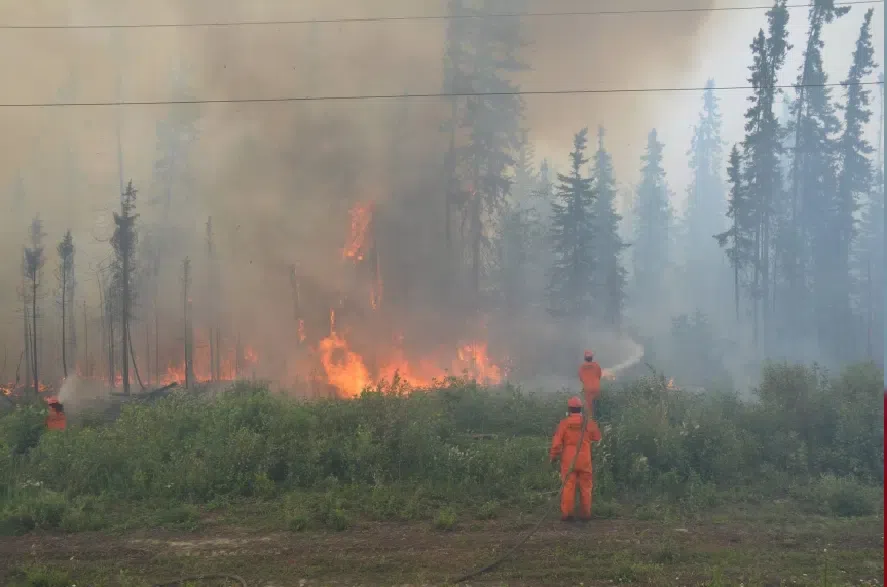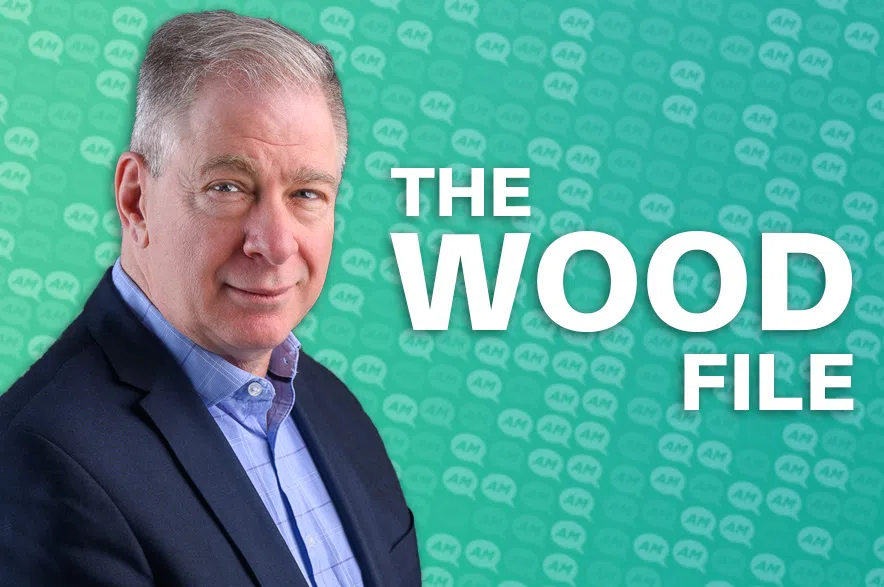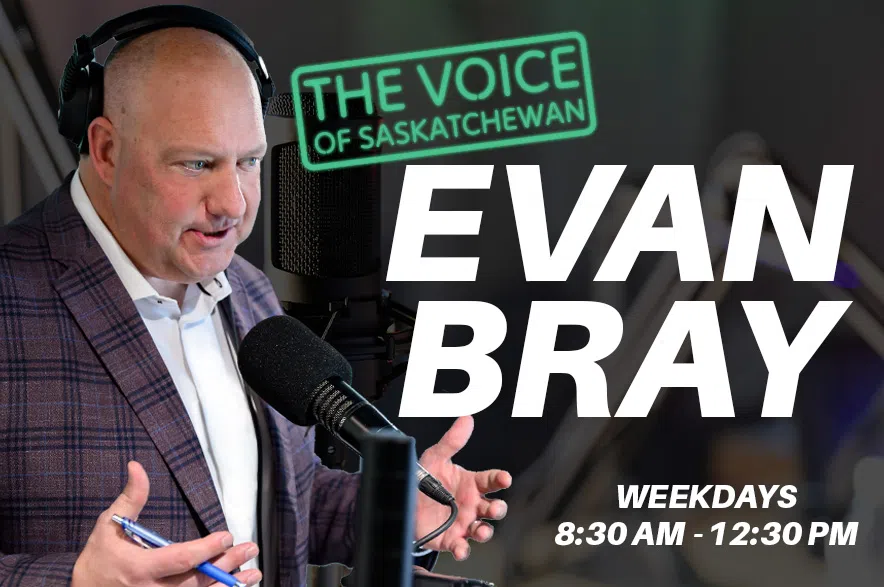There were 14 active fires burning in Saskatchewan on Saturday, with seven of the blazes not contained.
Saskatchewan Public Safety Agency (SPSA) said in its daily report on May 24 that two of the fires were under ongoing assessment and one was considered active, with action focused on cabins and infrastructure. Four fires were considered contained.
Read more:
- Register property at risk from wildfires, Sask. Public Safety Agency urges
- Northern Sask. outfitter encourages extreme caution this wildfire season
Contained means suppression action is taking place and the fire is not expected to grow in size, ongoing Assessment means the fire is being monitored regularly to assess risk to values in the area and not contained means suppression action is taking place but the fire is expected to grow in size, according to SPSA.
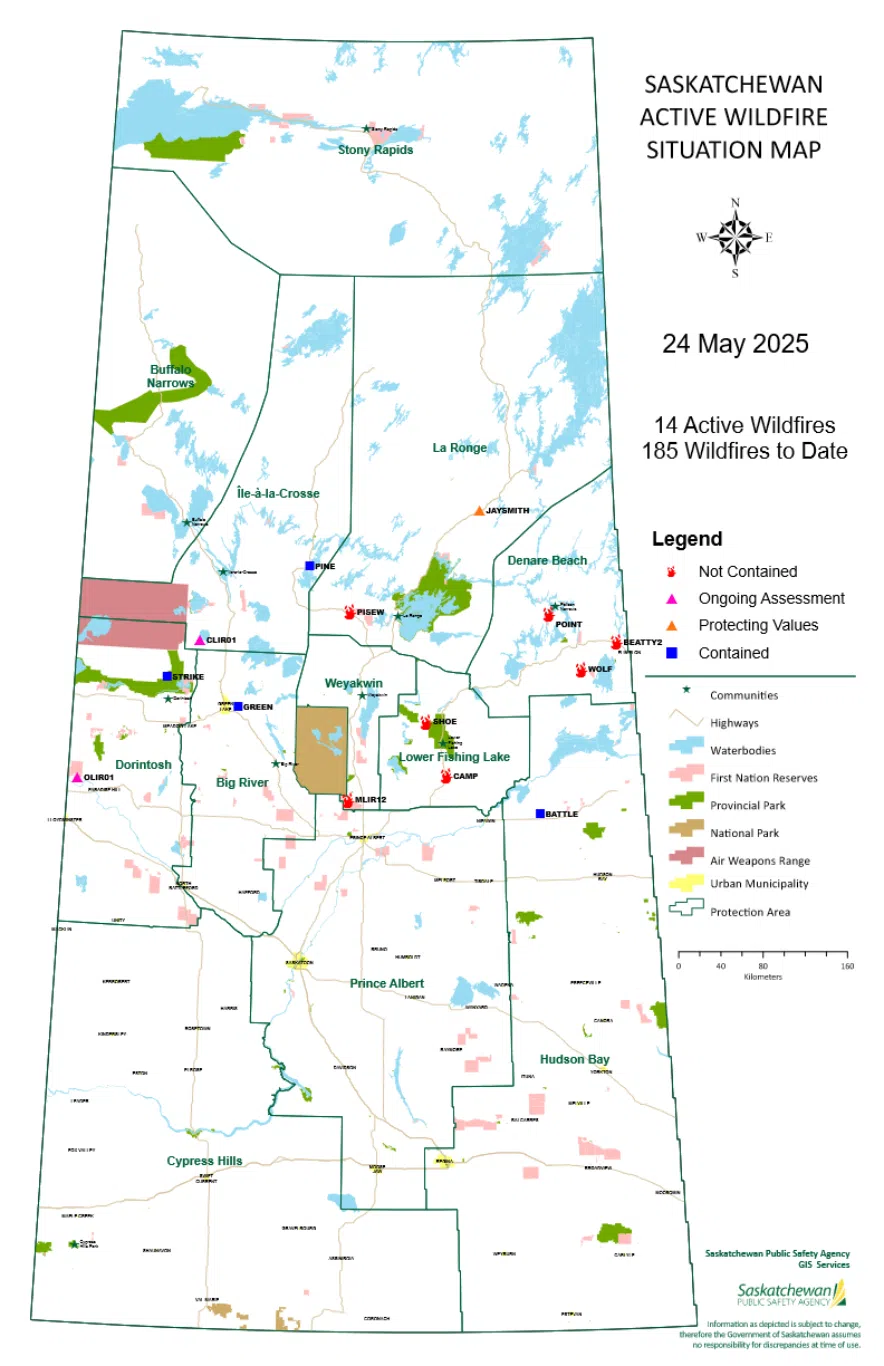
(Saskatchewan Public Safety Agency)
The Saskatchewan Public Safety Agency (SPSA) confirmed late Friday afternoon that people at Little Bear Lake Campground about 4 kilometres off of Hanson Lake Road at Mile 62, Highway 106, north of Smeaton had been told to leave.
The area is being threatened by the Shoe Fire that started around Lower Fishing Lake. It has already caused significant damage and the closure of some campgrounds in Narrow Hills Provincial Park and has now grown to 21,522 hectares in size. Some highways in the area remain closed.
East Trout Lake has also been evacuated due to the wildfire threatening a portion of the access road Highway 927. The resort subdivision issued a Declaration of Local Emergency as well. East Trout-Nipekamew Lakes Recreation site is closed and the communities of Whiteswan and Whelan Bay are on pre-evacuation alert.
On Saturday, Environment and Climate Change Canada was forecasting widespread smoke affecting air quality all weekend in areas of northern Saskatchewan including La Ronge, Prince Albert National Park, Narrow Hills Provincial Park, Pelican Narrows, Cumberland House, Creighton, Wollaston Lake, Collins Bay, Southend, Brabant Lake, Kinoosao.
Local smoke was forecast to affect air quality in Île à la Crosse, Buffalo Narrows, Beauval, Cree Lake and Key Lake.
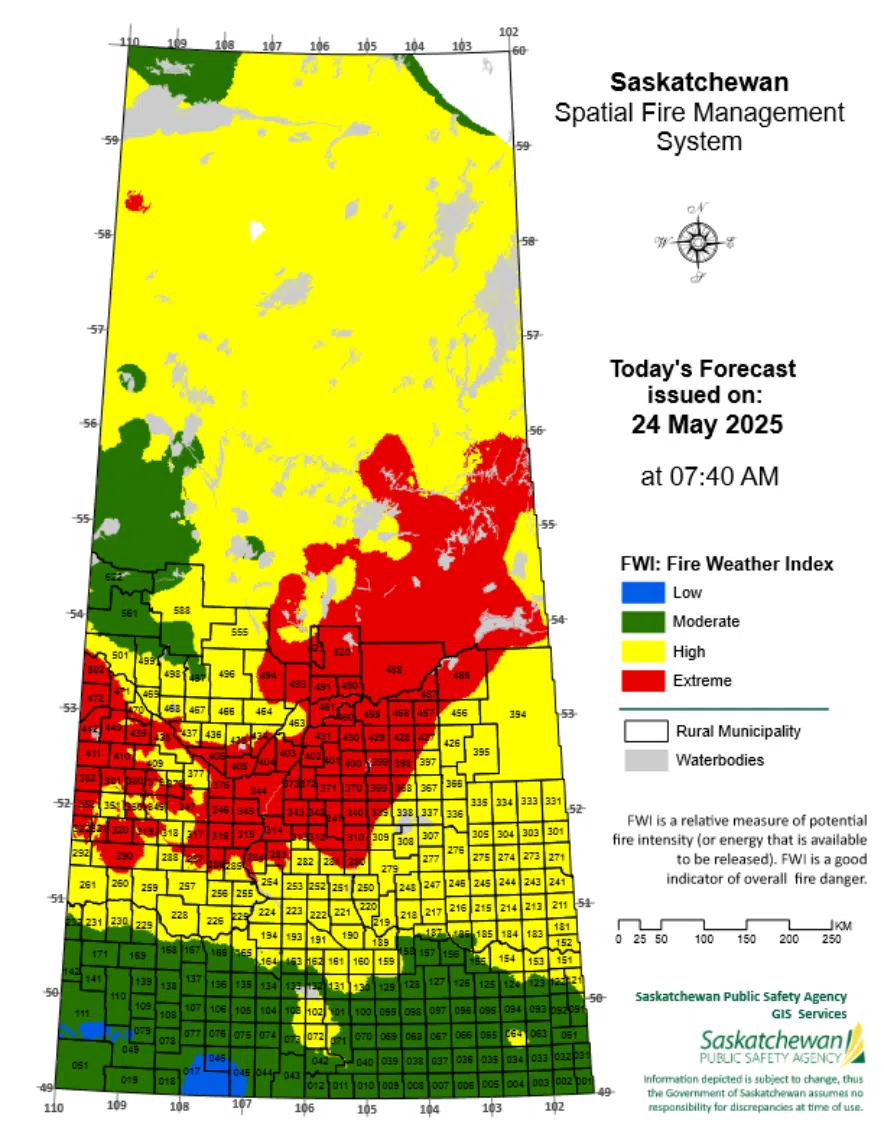
(Saskatchewan Public Safety Agency)
As well, fire bans are active in 27 urban municipalities, 43 rural municipalities and 15 provincial parks in the province, with the fire danger considered high to extreme in northern parts of the province and moderate over much of the southern part of Saskatchewan.
SPSA says there have been 187 fires in Saskatchewan so far in 2025. The five-year average to date for Saskatchewan wildfires is 161.
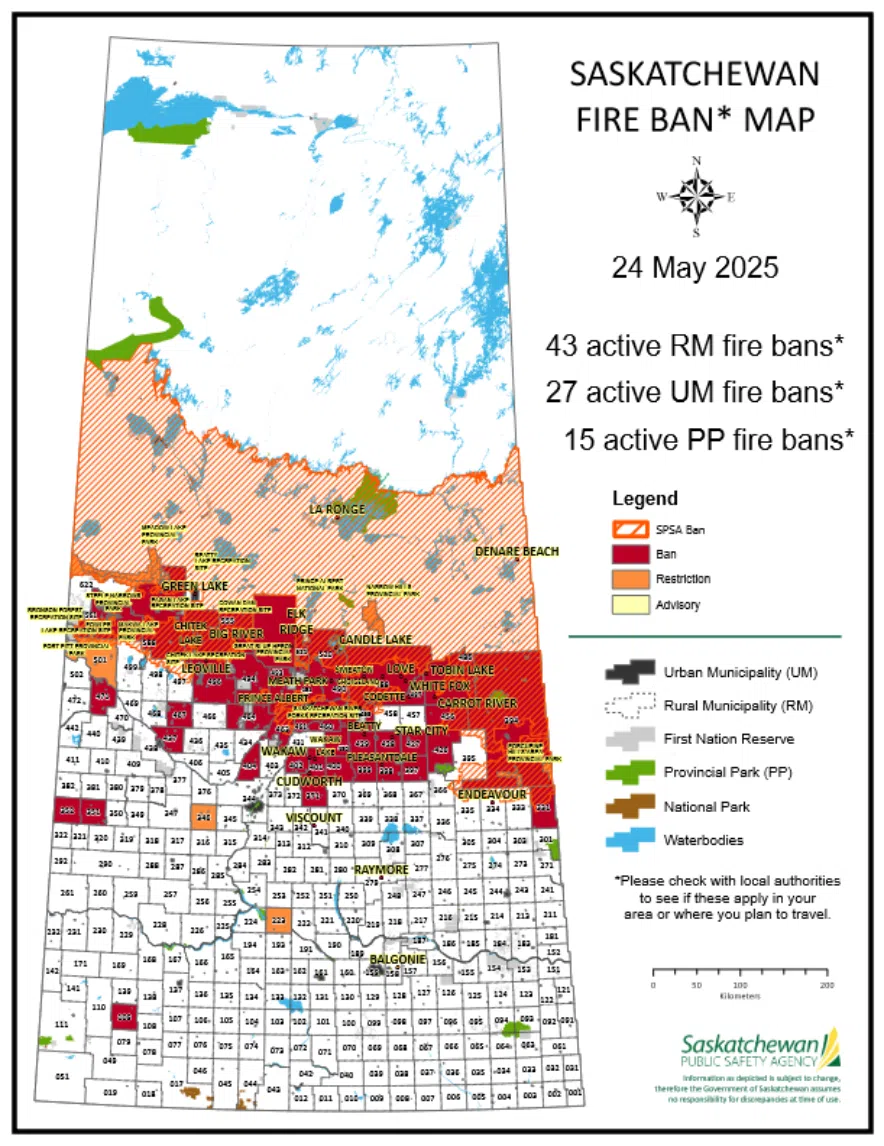
(Saskatchewan Public Safety Agency)
Everything you need to know about fire bans in Saskatchewan
SPSA provides the following information about fire bans in the province:
Is there a fire ban? If so, where?
• The interactive fire ban map found on saskpublicsafety.ca provides a view of the current, active fire bans and restrictions in Saskatchewan.
• If a local authority such as a municipality, a park or the SPSA have implemented a fire ban, details of each authoritie’s restrictions put in place can be found within the interactive map here.
• Check with a local authority for their bylaws and fire ban details. You should also check with the campground that you’re staying in for any fire restrictions they may have implemented.
Why was a fire ban implemented?
• The SPSA along with other Saskatchewan local authorities, such as a municipality, park or First
Nations, have the authority to issue their own fire bans.
• A local authority may issue a fire ban when the risk of wildfires is deemed high and there is a need to
reduce the likelihood of unwanted human-caused wildfires.
• The SPSA can issue a fire ban within Crown land, provincial parks, recreational areas, and the NSAD (Northern Saskatchewan Administration District).
• Each day, the SPSA assesses the implementation of a fire ban based on prevailing wildfire risks, ongoing
wildfire occurrences, potential for new wildfires and long-range weather predictions.
When will a fire ban be lifted?
• It is up to the authority who issued the ban to rescind or modify the fire ban.
• A fire ban will be lifted or adjusted according to fluctuations in risk.
What fines or penalties are in place for violating a fire ban?
• As per The Wildfire Act, those in violation of a provincial fire ban order can face a fine of up to
$500,000 per day (or part day) and/or imprisonment for up to three years. They could also be liable for covering the costs of the resulting wildfire.
• If someone violates a municipal fire bylaw, the fine would be pursuant to the municipal bylaw.
Why is there still a fire ban when it’s been rainy and/or cold for days?
• Although there may have been cooler temperatures and precipitation in some areas, the overall risk of
wildfire can remain.
• If there are other fires burning across the province, local personnel may be deployed to those fires,
which limits the resources available in lower-risk areas.
Is Crown land closed to the public during a fire ban?
• Crown land is not typically closed during a fire ban.
Who enforces the fire ban?
• Enforcement for fire bans is up to the jurisdiction. For example, in an RM or municipality, it would be
the bylaw officer. In parks, it would be conservation officers or RCMP.
• SPSA would only be the enforcement lead on vacant Crown land.
Can I have a campfire?
• No, a fire ban means that campfires are not permitted as they represent a significant fire risk.
What types of outdoor cooking appliances are allowed during a fire ban?
• Propane and gas appliances, along with liquid fuelled stoves are permitted.
• Grills using charcoal briquettes are also permitted.
Are fireworks, firecrackers or sky lanterns allowed during a fire ban?
• No, fireworks, firecrackers and sky lanterns are not allowed during a fire ban as they pose a significant
fire risk.
Are there restrictions on smoking in the areas covered under the ban?
• No, but visitors and residents are reminded to exercise extreme caution to help prevent wildfire. Properly dispose of smoking materials such as cigarettes.
— with files from PA Now
Read more:
